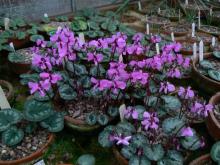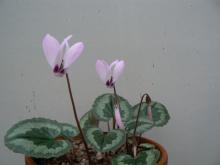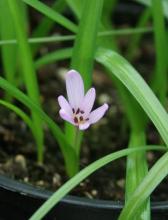Crocus minimus RBGG Corsica
A small crocus I collected near the sea
Roland
Comments
Re: What's flowering today
Ambrosina bassii RBGG Sicily
collected in the full sun in January
almost impossible to find , so small
with funny ,wooden shoe shaped flowersRoland
Ambrosina bassii is a funny little plant, had to look this one up as I'm not familiar with it. Apparently is the only species in this aroid genus and is considered quite rare. Found a PDF link on the plant; fascinating flower construction. Roland, does it take any frost?
http://www.edb.ups-tlse.fr/equipe3/MG/publis/Ambrosina.pdf
Re: What's flowering today
So nice to see live flowers at this time of year. Thanks, Roland.
Regarding Ambrosina bassii:
- Nature's wonders never cease. I found that PDF, too, Mark. I wasn't sure which end of the flower connected to the plant. I thought the pointed end might be a spur, but once I saw it was an aroid, of course that clinched it.
I went out to see if I still had any Hamamelis virginiana (Witchhazel) still blooming today, but not really. The near 0˚F (-18˚C) temperature we had a few days ago did nearly all of them in.
This was our Thanksgiving bouquet this year, featuring the Witchhazel. Can anyone guess what the conifer foliage is? (Hint: it is only one species.)
Re: What's flowering today
This was our Thanksgiving bouquet this year, featuring the Witchhazel. Can anyone guess what the conifer foliage is? (Hint: it is only one species.)
Must be Microbiota decussata (Siberian Cypress, and several other common names)! I really need to grow this, I have long admired it and it is very hardy (obviously, if growing in your climate Rick!). By the way, I like how you have extended the garden into the house, by showing us a number of times, cut floral decorations inside, really does bring the garden inside to enjoy. Not sure why I never think to do such things.
Re: What's flowering today
Thanks, Mark. I do grow Microbiota decussata. It is very cold hardy and another good one for foliage in arrangements. But no, that's not what is in the photo. Depending on how much sun it gets, Siberian (or Russian) Cypress will have a mauve winter color, and the undersides not so markedly different. This spray was grown in mostly shade:
The underside is lighter green, but there is no white.
Re: What's flowering today
Err, okay.... I'll display my general ignorance of trees and guess Thuja occidentalis... though I'm not sure how the clue would fit that? ??? ???
EDIT: Oh, I think I get the clue now (doh!)... You meant that the green sprigs and the silvery sprigs are a single species, right? (I was thinking before that you meant it was a monospecific genus.)
Re: What's flowering today
I fount the Ambrosiana in corsica almost alone as single plants
In Sicily they where many times with a few together
probably because Corsica is much cooler in the winter as Sicily (plants hardly set seed)
The plant from Corsica I collected died the first winter (I forgot to bring in the pot)
one night -3°C was enough to kill it
so Mark be careful , where it grows there is almost never frost
The plants from Sicily slept one year
I will post later other pictures from plants with different leaf-shapes
Roland
Re: What's flowering today
So nice to see live flowers at this time of year. Thanks, Roland.
Regarding Ambrosina bassii:
- Nature's wonders never cease. I found that PDF, too, Mark. I wasn't sure which end of the flower connected to the plant. I thought the pointed end might be a spur, but once I saw it was an aroid, of course that clinched it.I went out to see if I still had any Hamamelis virginiana (Witchhazel) still blooming today, but not really. The near 0˚F (-18˚C) temperature we had a few days ago did nearly all of them in.
This was our Thanksgiving bouquet this year, featuring the Witchhazel. Can anyone guess what the conifer foliage is? (Hint: it is only one species.)
I was thinking of Callitropis nootkatensis, but I believe that genus has two species!
Re: What's flowering today
Platycladus orientalis?
Re: What's flowering today
Regarding the foliage in the vase arrangement, Thuja occidentalis and the very closely related Platycladus orientalis are not the identity either. Trond, your guess of Callitropis (Xanthocyparis, Chamaecyparis) nootkatensis is a good one, as any species from that subfamily has whiter undersides. (And I wouldn't be growing the recently discovered species native to Vietnam.) But again, wrong answer.
What is shown is Thuja koraiensis, which unlike the other species of the genus, possesses one of the most contrasting color changing in respect to upper and lower rsides of foliage. Another pic:
Re: What's flowering today
Rick, you know, I didn't understand that the whitecoloured sprigs was the same plant at all - I didn't even recognize it as a conifer! I see it now. I too thought like Lori that you meant a monospecific genus ;D
I don't think I have ever seen Thuja koraiensis, at least do I not remember any. Seems to be a beautiful conifer.
Re: What's flowering today
Ambrosina bassii RBGG Sicily
collected in the full sun in January
almost impossible to find , so small
with funny ,wooden shoe shaped flowersRoland
Roland, is this one hardy? I have never seen anything like it before.
Is the Crocus and snowdrops flowering now?
Re: What's flowering today
Roland, is this one hardy? I have never seen anything like it before.
Is the Crocus and snowdrops flowering now?
Ambrosiana is absolutely not hardy
probably as soon as the soil freezes they die
they are wintergreen
so as soon as they freeze
you just have the corms under the ground
I found them 10-12 cm deep in Sicily
but just 5 cm deep in Corsica
The Crocus and Galanthus are now flowering
Roland
Re: What's flowering today
I too thought like Lori that you meant a monospecific genus ;D
That didn't even occur to me. I said it was one species because I thought that some would think there were two kinds of foliage, when if fact there is only one. My previous responses must have been very confusing... :D
Re: What's flowering today
I said it was one species because I thought that some would think there were two kinds of foliage, when if fact there is only one.
Exact what I thought
but my English isn't that good
Roland
Re: What's flowering today
I too thought like Lori that you meant a monospecific genus ;D
That didn't even occur to me. I said it was one species because I thought that some would think there were two kinds of foliage, when if fact there is only one. My previous responses must have been very confusing... :D
I realized what you meant when I suddenly saw the white "thing" as conifer foliage ;D ;D ;D
Re: What's flowering today
I too thought like Lori that you meant a monospecific genus ;D
That didn't even occur to me. I said it was one species because I thought that some would think there were two kinds of foliage, when if fact there is only one. My previous responses must have been very confusing... :D
Oh, me too, that's why I suggested Microbiota, it's a monospecific genus, and the leaves (at least the green side) look similar to your plant. I also didn't realize that the white foliage was the backside of the leaves. It is amazing that the backside is so completely silvery white compared to the top side of the leaves, is that color difference perceptable on the plant as the leaves present themselves?
Re: What's flowering today
It is amazing that the backside is so completely silvery white compared to the top side of the leaves, is that color difference perceptable on the plant as the leaves present themselves?
Though I try to bring things outside to photograph in good ambient light, and get better detail and less shadowing, I had to take the vase photo with flash. In fact I took several pics at different settings, and you see the best of the lot. Sheesh, you should see how white the back sides were when the green side was true color!
The photos below show the contrast more truly. (And yes, the "white" does have a slight blue tint to it.)
On my small tree, you don't normally see the white undersides without physically picking up and turning over the branches, except at the top where there is a little temporary natural twisting of the foliage (as shown in my previous post). As the tree grows taller and one looks up at, it will be a glorious site!
The species is normally an understory shrub with a wide, sprawling growth habit similar to Taxus canadensis. Branches are always ascending, but lay down as they get too tall and heavy. There are tree forms that are much sought after, as the open bush habit is not very attractive. I don't think you'll ever find the bush form for sale or even to see, except at botanic gardens.
My specimen was grown from a cutting, legally taken from the Morton Arboretum in Chicago, 14 years ago. Though the Arboretum had both bush and tree forms, the tree forms didn't seem very healthy, comparatively speaking, so I only took a few cuttings from the bush form. There were two specimens, each about 12ft in diameter and 3ft high, living in the open shade of a tall pine grove. It was interesting that every sprawling branch end attained the exact same height.
I grew the cuttings in full sun and eight years later, I detected the beginnings (maybe) of strong vertical growth. Imagine my cautious excitement, that I might be able to grow a Korean arborvitae TREE! :o Now six years later, my tree is up to 6ft (and 9ft wide). As is often the case with conifers, the leader is building steam and seems to be stealing vigor form the sprawling branches, which now only stand up to 2ft. So the specimen is looking more and more like a real tree, but with a skirt of sprawling branches. It is just to the point where a strong wind can pick up the elevated branches on the vertical stem to flash a glimpse of the white undersides. It's so cool.8) The white you see in this photo is morning frost on top of the foliage.
Re: What's flowering today
Wanting to "flower" today, high up in the 25 ft tree,
Salix chaenomeloides catkin
Did you climb to the top, Rick?
Rick, is it possible for you to send me a twig or two from T. koraiensis? (All I want for Christmas is a twig or two... ;D ;D ;D)
Re: What's flowering today
Wanting to "flower" today, high up in the 25 ft tree,
Did you climb to the top, Rick?
The advantage of a 10x optical zoom on my little point and shoot camera...
(I was on my tippy-toes, too.)
I'll pm you, Trond, regarding the Thuja cuttings.
Re: What's flowering today
A few from the last Nerines in flower
Nerine Hawaii a sarniensis hybrid
and Nerine Elspeth
a tiny one just 25 cm tall
Re: What's flowering today
A few from the last Nerines in flower
I've got 2 N. sarniensis bulbs in pots that bloomed last year, they were outside in part shade all summer and are now still dormant inside. Any tips on getting them to rebloom? I've been watering them every week or so, but still no sign of growth. :-\
Re: What's flowering today
I never start watering till they send up a scape, usually after a dry and warm summer rest.
This one has one has still one flowering scape. It has been in flower or months. (It is only one pot)
Re: What's flowering today
Amy
It depends on how you treated the Nerine the year before
Most Nerines make the flower-but one year before
this means what you did wrong last year
can result in no flowers this year
Roland
Re: What's flowering today
Amy
It depends on how you treated the Nerine the year before
Most Nerines make the flower-but one year before
this means what you did wrong last year
can result in no flowers this yearRoland
OK, I'll keep my fingers crossed and hope for the best.
I never start watering till they send up a scape, usually after a dry and warm summer rest.
This one has one has still one flowering scape. It has been in flower or months. (It is only one pot)
It had leaves on it through most of the summer, so I kept watering it! Doh!! :P I'll know better now.
Thanks to you both for the advice!!
Re: What's flowering today
Amy, my plant starts producing leaves in winter/spring and the leaves die down in summer when the weather gets warmer. I stand the pot in a place where it is warm and dry all summer. In fall, about August-September almost all the bulbs in the pot produce scapes but no leaves. I water a little but not much till the leaves start developing later in winter.
Re: What's flowering today
A couple of cyclamen.
The Cyclamen alpinum is on time but I would have expected the Cyclamen pseudibericum in about three months
Re: What's flowering today
Few plants are flowering outside now, but here are two:
This hellebore is always early, left yesterday - right last year Jan 2.
This Mahonia is always early. Often it starts flowering in November. In fact it is later than usually probably caused by the two cold last winters.
Re: What's flowering today
Well, that's zone 8 for you!
Re: What's flowering today
Well, that's zone 8 for you!
Maybe the winter is z 8 but the summer is not ;)




Ambrosina bassii RBGG Sicily
collected in the full sun in January
almost impossible to find , so small
with funny ,wooden shoe shaped flowers
Roland